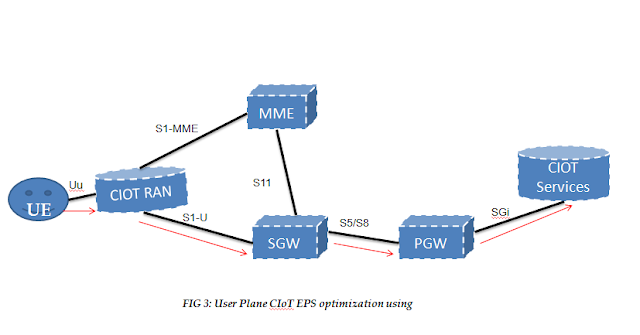POWER CONTROL IN LTE
Home LTE NB-IoT 5G(NR-NSA)
POWER CONTROL IN LTE
When dealing with wireless
communication of any kind, one of the most important things to keep in mind is
the kind of effect/change that the air interface is going to make on the
signal. Unlike wires, air is not a static, immutable path whose effect on the
signal can be predicted with a fairly high accuracy. The signal, when
travelling through the air interface goes through distortion, attenuation,
reflection through multiple surfaces, and many other things. So, it’s important
for both the UE and the eNodeB, to have some kind of arrangement to take care
of this.
Power Control is the
mechanism through which the UE and the eNodeB handle the attenuation of the
signal. There are two types of Power Control mechanisms as per Control Theory and
LTE uses both of them. They are:
- Open Loop Power Control
- Closed Loop Power Control
What is Open Loop Power Control?
In case of Open Loop, no feedback
is sent from the receiver to the transmitter informing the latter to either
ramp up or lowers the power of the signal. This mechanism is used during the
Random Access process.
- When a UE is powered on, after frequency scanning, it decodes the MIB and SIBs that are broadcasted periodically by the eNodeB. In SIB2, there is an IE called preambleInitialReceivedTargetPower.
- It tells the UE the value of transmission power (in dB) of the first uplink message that the UE will send to the eNodeB, which is the Random Access Request (RAR) message.
- In SIB2, the eNodeB also sends an IE called referenceSignalPower which tells the UE the power with which the reference signal was transmitted from the eNodeB.
- The UE decodes the value of the referenceSignalPower and also measures the strength of the reference signal.
- Based on this, it calculated the path loss (PL = Reference Signal Power – RSRP measurements) of the signal. When sending the RAR message, the UE will consider the path loss and the preambleInitialReceivedTargetPower and set the transmission power accordingly.
- If the UE does not receive a Random Access Response message from the first attempt, it will ramp up the transmission power by the step size mentioned in powerRampingStep IE in SIB2.
What is Closed Loop Power Control?
In Closed Loop mechanism,
the receiver, on receiving a signal, sends a feedback to the transmitter
telling it to increase/decrease the transmission power. As you may have
guessed, a Closed Loop mechanism can only work once the transmitter and
received have already established a communication i.e. the first signal that
was transmitted was received and decoded properly and hence the feedback was
sent and also decoded perfectly. This mechanism is used in LTE in the form of
Transmission Power Control.
The TPC command is
delivered to the UE through the following DCI Formats:
- DCI format 3
- DCI format 3A
- DCI format 4
DCI 0 may be used for TCP command.
On establishing RRC connection with the eNB, the UE starts using Closed Loop Power Control on PUSCH and PUCCH channels.
On establishing RRC connection with the eNB, the UE starts using Closed Loop Power Control on PUSCH and PUCCH channels.
PUSCH
The power with which the
UE transmits data on the PUSCH is given by the formula:
Power
= min{Pmax, 10log10(RBs) + PO + alphaPL + deltatf + f(i)}
Where,
10log10(RBs)
- the amount of additional power that is needed based on the size of the RB
allocation,with
power being directly proportional to the number of RBs,
PO - It is the assumed value of interference that the UE is expected to overcome.
It is composed of:
P0_Nominal_PUSCH – it is
communicated over SIB2. It is valid for all UEs in the cell.
P0_UE_PUSCH – it is a
UE-specific value. It is optional.
alphaPL – PL stands for Path Loss and alpha(Rance-0,0.4,0.5,0.6,0.7,0.8,0.9,1) is the impact of the path loss. The value of alpha is communicated to UE in SIB2. If alpha = 1, then all of the Path Loss needs to be taken into account to calculate Power Control. The value of alpha could be hardcoded by vendors and it’s used for fractional power control.
deltatf – It is the MSC-specific component of the formula. It tells the UE if the eNB wants it to change itd power based on the MCS that is assigned to it.
f(i) – it is the closed loop feedback given by the eNB based on which the UE will add additional power to the transmission.
Thus, the two main components controlling power in PUSCH are:
a)
PO_nominal_PUSCH
b)
Alpha
PUCCH
The formula for power
control in PUCCH is:
Power
= min{Pmax, PO + alphaPL + deltatf + f(i)}
Where everything else is the same except PO is composed of P0_Nominal_PUCCH and P0_UE_PUCCH.
Also, the f(i) value is
different for each format type of the PUCCH, so a different value is given to
the UE in SIB2 for formats 1, 1a, 1b, 2, 2a and 2b.
Hence, the parameters that control the transmit power in PUCCH are:
a)
PO_nominal_PUCCH
b)
Alpha
One might think that a high value of UL transmission power will result in high BLER, high Throughput, and thus high UL SINR. But, in high capacity areas like airports, events, convention centers, etc. this might have the opposite effect. Thus, it is recommended that the UL RSSI should be analyzed in these types of venues during high capacity scenarios.
Both of the Power Control
mechanisms mentioned above are used for uplink data transmission. For downlink
transmission, instead of power control, rate control is used i.e. through
Adaptive Modulation and Coding scheme, the Modulation scheme (QPSK, 16 QAM, 64
QAM) and Coding Rate are varied according to the channel conditions.







Comments
Post a Comment